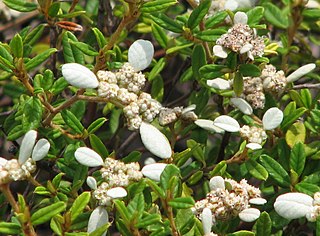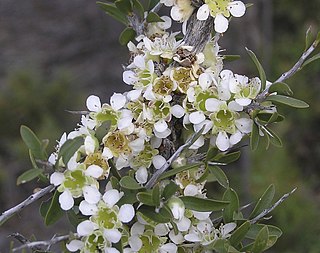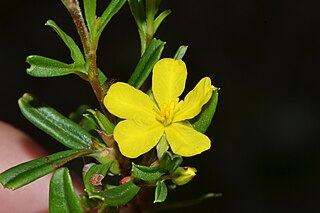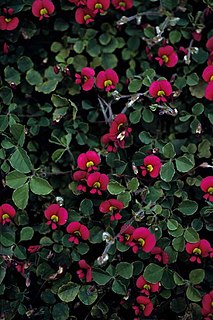
Chorilaena quercifolia, commonly known as karri oak or chorilaena, is a species of bushy shrub that is endemic to the karri forests of south-west Western Australia. It is the sole species in the genus Chorilaena. It has papery, broadly egg-shaped leaves with lobed edges and variously-coloured flowers arranged in umbels of five, the sepals and petals hairy on the outside and the stamens protruding beyond the petals.

Spyridium is a genus of about thirty species of flowering plants in the family Rhamnaceae, and is endemic to Australia. Plants in the genus Spyridium are shrubs or subshrubs usually with small leaves, flowers usually in clusters of small composite heads, the individual flowers small and densely woolly-hairy, and the fruit a capsule. Species of Spyridium are found in all Australian states except Queensland.
Enumeratio plantarum quas in Novae Hollandiæ ora austro-occidentali ad fluvium Cygnorum et in sinu Regis Georgii collegit Carolus Liber Baro de Hügel is a description of the plants collected at the Swan River colony and King George Sound in Western Australia. The author, Stephan Endlicher, used a collection arranged by Charles von Hügel to compile the first flora for the new settlements. Hugel visited the region during 1833–1834, several years after the founding of the colony. The work provided formal descriptions, in Latin, of new species and genera of plants. The single instalment was produced in Europe by Endlicher in 1837, the work also included contributions by Eduard Fenzl, George Bentham, Heinrich Wilhelm Schott.

Gompholobium huegelii, commonly known as common wedge-pea is a species of flowering plant in the family Fabaceae and is endemic to south-eastern Australia. It is an erect or spreading shrub with trifoliate leaves and cream-coloured to yellow and greenish, pea-like flowers.

Pomaderris ferruginea, commonly known as rusty pomaderris, is a species of flowering plant in the family Rhamnaceae and is endemic to south-eastern continental Australia. It is a shrub with rusty-hairy stems, egg-shaped leaves, and clusters of cream-coloured, whitish or yellow flowers.

Leptospermum spinescens, commonly known as the spiny tea tree, is a species of spiny shrub that is endemic to Western Australia. It has thick, egg-shaped to elliptical leaves on a short petiole, white or greenish cream flowers, and fruit that remain in the plant for years after reaching maturity.
Hemiandra linearis, commonly known as speckled snakebush, is a species of prostrate to ascending shrub that is endemic to the south-west of Western Australia.

Pomaderris prunifolia, commonly known as plum leaf pomaderris, is a plant in the family Rhamnaceae. It has slightly toothed, wrinkled green leaves, stems with rusty coloured star-shaped hairs and yellow flowers.

Comesperma integerrimum is a twining shrub or climber in the family Polygalaceae.

Goodenia fasciculata is a species of flowering plant in the family Goodeniaceae and is endemic to the south-west of Western Australia. It an ascending shrub with bunched, narrow linear stem leaves and spikes of white flowers.

Goodenia pulchella is a species of flowering plant in the family Goodeniaceae and is endemic to the south-west of Western Australia. It is an erect to ascending herb with lance-shaped leaves mostly at the base of the plant, and racemes of yellow flowers.

Gompholobium aristatum is a species of flowering plant in the family Fabaceae and is endemic to the south-west of Western Australia. It an erect shrub that typically grows to a height of 10–80 cm (3.9–31.5 in). It flowers between July and December producing yellow, pea-like flowers. This species was first formally described in 1837 by George Bentham in Stephan Endlicher's Enumeratio plantarum quas in Novae Hollandiae ora austro-occidentali ad fluvium Cygnorum et in sinu Regis Georgii collegit Carolus Liber Baro de Hügel from specimens collected in the Swan River Colony. The specific epithet (aristatum) means "awned", referring to the leaves.

Hibbertia racemosa, commonly known as stalked guinea flower, is a species of flowering plant in the family Dilleniaceae and is endemic to the south-west of Western Australia. It is an erect or ascending, spreading shrub that typically grows to a height of 10–75 cm (3.9–29.5 in) and produces yellow flowers between July and December.

Kennedia carinata is a species of flowering plant in the family Fabaceae and is endemic to the south-west of Western Australia. It is a prostrate shrub with trifoliate leaves and reddish-purple, pea-like flowers.

Daviesia flexuosa is a species of flowering plant in the family Fabaceae and is endemic to the south-west coast of Western Australia. It is a glabrous, spreading shrub with zig-zagged branchlets, scattered, sharply-pointed, narrowly triangular phyllodes and yellow and red flowers.
Lasiopetalum cordifolium, is a species of flowering plant in the family Malvaceae and is endemic to the south-west of Western Australia. It is an erect shrub with hairy stems, heart-shaped leaves and pink, cream-coloured or white flowers.

Sphaerolobium alatum is a species of flowering plant in the family Fabaceae and is endemic to the south of Western Australia. It is a slender, leafless shrub with yellow and reddish-brown flowers from September to November.
Sphaerolobium fornicatum is a species of flowering plant in the family Fabaceae and is endemic to the far south-west of Western Australia. It is a leafless shrub that typically grows to a height of 0.1–1 m and has yellow or orange and red flowers from October to January.

Sphaerolobium grandiflorum is a species of flowering plant in the family Fabaceae and is endemic to the south of Western Australia. It is an erect, slender, leafless shrub with red, yellow and orange flowers.

Sphaerolobium linophyllum is a species of flowering plant in the family Fabaceae and is endemic to the south of Western Australia. It is a prostrate to ascending shrub with a few narrowly linear leaves and red, yellow and orange flowers.
















